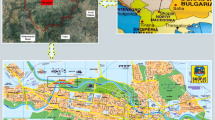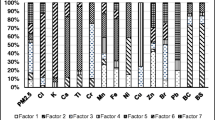Abstract
The vehicular emission is the main source of fine particles in Brazilian Cities. A comprehensive study was performed from 2007 to 2009 with 24 h daily sampling of fine particles in an experimental site in six Brazilian capitals: Sao Paulo, Rio de Janeiro, Curitiba, Porto Alegre, Recife and Belo Horizonte. The polycarbonate filters collected at each site with Harvard sampling, were submitted to gravimetrical analysis for identification of PM2.5 concentration, to reflectance for Black Carbon concentration, to X-ray fluorescence analysis for elemental composition and to ion chromatography for an ion sand cations composition and concentration. The average PM2.5 concentration were 28, 19, 17, 17, 16 and 11 μg/m3 in São Paulo, Rio de Janeiro, Belo Horizonte, Curitiba, Porto Alegre and Recife, respectively. Black Carbon accounted for approximately 30 % of the PM2.5 mass concentration in the more air pollution impacted cities: Sao Paulo, Rio de Janeiro and Belo Horizonte. The Black Carbon was used as a tracer for diesel fuel emission and biomass burning. The elemental chemical composition of the PM2.5 was used to identify source-related fractions of fine particles, by means of Receptor Models. The results were used to examine the association of these fractions with daily mortality in each of the six cities. Principal Matrix Factorization (PMF) was applied to the elemental concentration data in order to identify the sources of fine particles, specifically the participation of the vehicular emission. These results were compared to the previous analysis performed with Absolute Principal Component Analysis (APCA). The participation of the vehicular fleet to the PM2.5 mass concentration was significant, explaining in the most urbanized area even 40 % of its mass. These results show the relative importance of the vehicular emission to health injury.
You have full access to this open access chapter, Download conference paper PDF
Similar content being viewed by others
Keywords
The vehicular emission is the main source of fine particles in Brazilian Cities. A comprehensive study was performed from 2007 to 2009 with 24 h daily sampling of fine particles in an experimental site in six Brazilian capitals: Sao Paulo, Rio de Janeiro, Curitiba, Porto Alegre, Recife and Belo Horizonte. The polycarbonate filters collected at each site with Harvard sampling, were submitted to gravimetrical analysis for identification of PM2.5 concentration, to reflectance for Black Carbon concentration, to X-ray fluorescence analysis for elemental composition and to ion chromatography for an ion sand cations composition and concentration. The average PM2.5 concentration were 28, 19, 17, 17, 16 and 11 μg/m3 in São Paulo, Rio de Janeiro, Belo Horizonte, Curitiba, Porto Alegre and Recife, respectively. Black Carbon accounted for approximately 30 % of the PM2.5 mass concentration in the more air pollution impacted cities: Sao Paulo, Rio de Janeiro and Belo Horizonte. The Black Carbon was used as a tracer for diesel fuel emission and biomass burning. The elemental chemical composition of the PM2.5 was used to identify source-related fractions of fine particles, by means of Receptor Models. The results were used to examine the association of these fractions with daily mortality in each of the six cities. Principal Matrix Factorization (PMF) was applied to the elemental concentration data in order to identify the sources of fine particles, specifically the participation of the vehicular emission. These results were compared to the previous analysis performed with Absolute Principal Component Analysis (APCA). The participation of the vehicular fleet to the PM2.5 mass concentration was significant, explaining in the most urbanized area even 40 % of its mass. These results show the relative importance of the vehicular emission to health injury.
Author information
Authors and Affiliations
Corresponding author
Editor information
Editors and Affiliations
Rights and permissions
Copyright information
© 2014 Springer Science+Business Media Dordrecht
About this paper
Cite this paper
Andrade, M., Oyama, B., Fornaro, A., Miranda, R., Saldiva, P. (2014). Application of PMF for Evaluation of the Fine Particles Contribution from Vehicular Emission in Six Brazilian Cities. In: Steyn, D., Builtjes, P., Timmermans, R. (eds) Air Pollution Modeling and its Application XXII. NATO Science for Peace and Security Series C: Environmental Security. Springer, Dordrecht. https://doi.org/10.1007/978-94-007-5577-2_28
Download citation
DOI: https://doi.org/10.1007/978-94-007-5577-2_28
Published:
Publisher Name: Springer, Dordrecht
Print ISBN: 978-94-007-5576-5
Online ISBN: 978-94-007-5577-2
eBook Packages: Earth and Environmental ScienceEarth and Environmental Science (R0)




